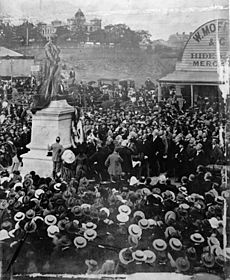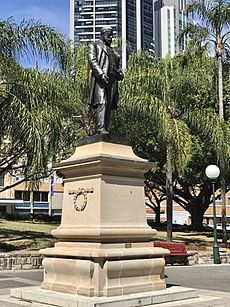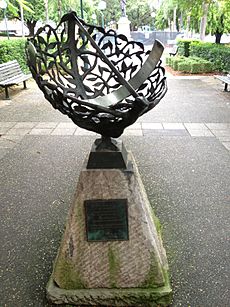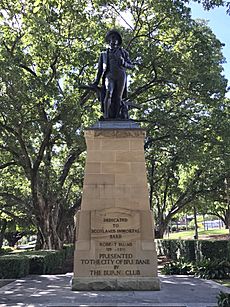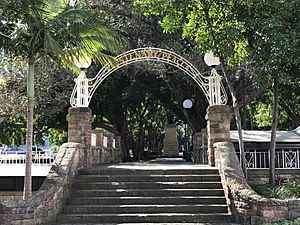Centenary Place facts for kids
Quick facts for kids Centenary Place |
|
|---|---|

Centenary Place, Brisbane
|
|
| Location | 85 Wickham Street, Fortitude Valley, City of Brisbane, Queensland, Australia |
| Built for | Brisbane City Council |
| Architect | Henry Moore |
| Owner | Brisbane City Council |
| Official name: Centenary Place, Centenary Park | |
| Type | state heritage (landscape) |
| Designated | 6 August 2007 |
| Reference no. | 602442 |
| Significant period | 1920s (fabric) 1920s-ongoing (historical use) |
| Lua error in Module:Location_map at line 420: attempt to index field 'wikibase' (a nil value). | |
Centenary Place is a special park in Fortitude Valley, Brisbane, Queensland, Australia. It's listed on the Queensland Heritage Register because of its important history and design. Many people also call it Centenary Park. This beautiful park was designed by Henry Moore.
Contents
Why Was Centenary Place Built?
Centenary Place was created to celebrate a big milestone: 100 years since Europeans first settled in Queensland, from 1824 to 1924. The Brisbane City Council started clearing the land in 1924, and the park was officially opened in 1925. It covers a large area of 8,748 square metres and is surrounded by Wickham Street, Ann Street, and Gotha Street.
This park was one of the last big projects by the old Brisbane City Council before the larger Greater Brisbane Council was formed in 1925. People have been using the park ever since it was built. It was also updated and made even better in 1999 and 2000.
Celebrating Queensland's History
Celebrating 100 years of European settlement was a huge event for Queensland. It was a chance to show how much the state had grown. Queensland had gone through many big changes, from being a penal colony (a place where prisoners were sent) to becoming a free settlement. It also separated from New South Wales and joined the Federation to become part of Australia. The First World War had also just ended. Creating Centenary Place gave people a special place to remember and celebrate these important moments.
To help with the celebrations, a Centenary Celebrations Committee was formed. They also started a Centenary Fund. Many events were held to raise money for this fund. The money was used for memorials, like Centenary Place. Other memorials included special medals, a statue of John Oxley (an early explorer), and the start of the John Oxley Library. Many trees were also planted across Brisbane.
How the Park Was Designed
The park was designed by Henry Moore, who was the Parks Superintendent for the Council. He also designed other famous parks like New Farm Park and Newstead Park. Moore used a formal style for Centenary Place. This means it has clear layouts, planted garden beds, grassy areas, low sandstone walls, and curved paths.
The park is home to many mature trees. These include poinciana trees, Canary Island date palms, Queen palms, wine palms, and different types of fig trees like weeping figs and white figs. In 1947, Harry Oakman, another Parks Director, planned even more garden beds along the paths. These were mostly in place by 1950.
The Catholic Church was very interested in Centenary Place. They hoped the park would become the front area for a huge new church they planned to build, called the Holy Name Cathedral. This cathedral was meant to be a massive building nearby. Because of this, the park's design includes a central path that was originally meant to lead to the cathedral's entrance. It's possible that Archbishop James Duhig and the church's architect, Jack Hennessy, helped with the park's design.
Statues in the Park
The park's original design included a special spot for a statue of Thomas Joseph Byrnes. He was a former Premier of Queensland (like a state leader). Byrnes was important because he was the first Queensland-born premier and the first Catholic premier. The statue was made by a famous sculptor named Sir Bertram Mackennal. It was first put up in 1902 at a different location called Petrie Bight. When Centenary Place was finished in 1925, the statue was moved to its current spot in the park.
Another important statue in the park is of the Scottish poet, Robert Burns. The idea for a statue of Burns in Brisbane came about as early as 1888. However, it wasn't until 1929 that the Brisbane Caledonian Society and Burns Club finally had the statue made and placed in the park. It's a tradition to place statues of Robert Burns so that his back faces a church. The statue in Centenary Place follows this tradition. If the Holy Name Cathedral had been built, the poet's back would have been turned towards it. The Burns statue is a popular spot for Brisbane's Scottish community, especially for events like Burns Night.
Speakers' Corner
From 1962 to the mid-1970s, Centenary Place was known as Brisbane's "speaker's corner". This meant it was a place where people could gather on Sunday afternoons to speak freely about all sorts of topics. Hundreds of people would come to listen. Speakers would talk about many issues, including campaigning for Aboriginal rights in the 1960s and 1970s. After this tradition ended at Centenary Place, Brisbane didn't have another official speaker's corner until 1990, when one was set up at King George Square.
Changes Over Time
Over the years, the park has changed quite a bit. In 1938, a tram waiting shelter was added. During World War II, two air raid shelters were built in the park. These were strong underground shelters to protect people during air attacks. Later, in the 1960s and 70s, these shelters were removed to make way for new toilet blocks. In 1977, the park was made a bit larger. Then, in 1999-2000, the park was extensively refurbished, bringing back its original formal look.
What Centenary Place Looks Like
Centenary Place is shaped like a teardrop and is surrounded by Ann, Wickham, and Gotha Streets. The park gently slopes downwards from the corner of Ann and Gotha Streets. A long path runs through the middle of the park, starting with a special archway at the narrow southern end. This path is the main "spine" of the park, lined with trees and featuring monuments along the way.
At the very centre of the park, you'll find the statue of Thomas Joseph Byrnes. This statue is in a large paved area where several paths meet. Curved paths also lead to the centre of the park from Ann and Wickham Streets.
Between the Byrnes statue and the archway, the central path goes through a shady area with mature fig trees and the monument to Robert Burns. At the northern end of the park, near Gotha Street, the central path has a sundial sculpture. This sundial was added in 1999 to celebrate the park's 75th anniversary.
The grassy areas in the park are clearly separated by formal paths, garden beds with mulch, hedges, and rows of trees. These include the large, old poincianas, weeping figs, white figs, Canary Island date palms, Queen palms, and wine palms. All these trees and plants give the park a beautiful, formal tropical look.
You'll also see sandstone walls with the park's name on them along Wickham and Ann Streets.
The Archway and Statues
At the city end of the park, there's a formal stone platform with steps and an arched gateway. This gateway leads into the central path. The archway is made of two stone pillars (called Brisbane Tuff) with a wrought iron arch connecting them. The ironwork spells out "Centenary Place" and holds glass lanterns on each side.
The stone platform is actually the roof of what used to be a tramways office. Now, it's a control centre for traffic lights. You can access this basement area by two steep, narrow concrete stairs. There's also a covered area on the Wickham Street side that was built in 1938 as a tram shelter.
The bronze statue of Robert Burns stands on a tall, stone base. This base has a rough granite bottom and a decorative top with thistle patterns (a Scottish symbol). Three sides of the base have bronze pictures, and the fourth side has the statue's inscription in bronze letters.
The Byrnes statue is also made of bronze and stands on a sandstone base. This base has a fancy bottom and top. There's a carved sandstone wreath on two sides of the base. One side has Byrnes' name and dates of birth and death. A small plaque on the base incorrectly says the sculptor was "Sir Bertram Macenell," but it was actually Sir Bertram Mackennal, and it was his fiftieth sculpture!
Why Centenary Place is Important
Centenary Place is listed on the Queensland Heritage Register because it's important for several reasons:
- It shows how Queensland's history has changed. The park was created in 1925 to celebrate 100 years of European settlement in Queensland. It shows how the state grew from a penal colony to a developed state. It's also important because it was a "speaker's corner" in the 1960s and 70s, where people could speak about important issues like Aboriginal rights.
- It has unique features. The park has an unusual structure made from a type of stone called Brisbane Tuff. This structure combines a formal archway and steps with a tramway office and passenger shelter, showing both ceremonial and practical uses.
- It's linked to famous designers. Centenary Place is strongly connected to the work of Henry Moore, who was Brisbane's first Parks Superintendent. He also designed New Farm Park and Newstead Park. It's also linked to Harry Oakman, who was the first trained landscape architect to work for the Queensland government.
- It's beautiful. The park is very appealing because of its formal stone archway and steps that lead into the main path. The long rows of mature trees like poincianas, palms, and fig trees create a pleasant view in the busy city area.
- It's important to different groups of people. The park has a strong connection to the Catholic community because it was chosen as the front area for the planned Holy Name Cathedral. It also has the statue of Thomas Joseph Byrnes, a prominent Catholic premier. The park is also very important to the Scottish community, who chose it for the statue of Robert Burns and use it for events like Burns Night.


